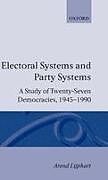Electoral Systems and Party Systems
Einband:
Fester Einband
EAN:
9780198273479
Genre:
Political Science
Autor:
Lijphart Arend
Herausgeber:
OUP Oxford
Erscheinungsdatum:
20.01.1994
Zusatztext ...this is a truly excellent book...Lijphart's book is necessary reading for anyone interested in the mechanics and consequences of the electoral systems. Klappentext An electoral system is the most fundamental element of representative democracy, translating citizen's votes into representative's seats. It is also the most potent practical instrument available to democratic reformers. This systematic and comprehensive study describes and classifies the 70 electoral systems used by 27 democracies - including those of Western Europe, Australia, Canada, the USA, Costa Rica, India, Israel, Japan, and New Zealand - for 384 national legislative and European Parliament elections between 1945 and 1990. Using comparative and statistical analyses of these systems, Arend Lijphart demonstrates the effect of the electoral formula used, the number of representatives elected per district, electoral thresholds, and five other key features of electoral systems on the proportionality of the election outcome, the degree of multipartism, and the creation of majority parties. In the process he reveals that electoral systems are neither as diverse nor as complex as is often assumed. Electoral Systems and Party Systems represents the most definitive treatment of the subject since Rae's classic study in 1967, based as it is on more accurate and comprehensive data (covering more countries and a longer time-span), and using stronger hypotheses and better analytical methods. The unique information and analysis it offers will make it essential reading for everyone working in the field. Zusammenfassung An electoral system is the most fundamental element of representative democracy, translating citizen's votes into representatives' seats. It is also the most potent practical instrument available to democratic reformers. This systematic and comprehensive study describes and classifies the 70 electoral systems used by 27 democracies - including those of Western Europe, Australia, Canada, the USA, Costa Rica, India, Israel, Japan, and New Zealand - for 384 national legislative and European Parliament elections between 1945 and 1990.Using comparative and statistical analyses of these systems, Arend Lijphart demonstrates the effect of the electoral formula used, the number of representatives elected per district, electoral thresholds, and of five other key features of electoral systems on the proportionality of the election outcome, the degree of multipartism, and the creation of majority parties. In the process he reveals that electoral systems are neither as diverse nor as complex as is often assumed.Electoral Systems and Party Systems represents the most definitive treatment of the subject since Rae's classic study in 1967, based as it is on more accurate and comprehensive data (covering more countries and a longer time-span), and using stronger hypotheses and better analytical methods. The unique information and analysis it offers will make it essential reading for everyone working in the field. Inhaltsverzeichnis 1: Introduction: Goals and Methods 2: Electoral Systems: Types, Patterns, Trends 3: Disproportionality, Multipartism, and Majority Victories 4: Changes in Election Rules Between Systems in the Same Country 5: Bivariate and Multivariate Analyses 6: Four Other Potential Explanations Appendices: A: Proportional Representation Formulas B: Indices of Disproportionality and Party System Characteristics C: Data: Sources, Additions, corrections, Clarifications ...
Klappentext
An electoral system is the most fundamental element of representative democracy, translating citizen's votes into representative's seats. It is also the most potent practical instrument available to democratic reformers. This systematic and comprehensive study describes and classifies the 70 electoral systems used by 27 democracies - including those of Western Europe, Australia, Canada, the USA, Costa Rica, India, Israel, Japan, and New Zealand - for 384 national legislative and European Parliament elections between 1945 and 1990. Using comparative and statistical analyses of these systems, Arend Lijphart demonstrates the effect of the electoral formula used, the number of representatives elected per district, electoral thresholds, and five other key features of electoral systems on the proportionality of the election outcome, the degree of multipartism, and the creation of majority parties. In the process he reveals that electoral systems are neither as diverse nor as complex as is often assumed. Electoral Systems and Party Systems represents the most definitive treatment of the subject since Rae's classic study in 1967, based as it is on more accurate and comprehensive data (covering more countries and a longer time-span), and using stronger hypotheses and better analytical methods. The unique information and analysis it offers will make it essential reading for everyone working in the field.
Inhalt
1: Introduction: Goals and Methods
2: Electoral Systems: Types, Patterns, Trends
3: Disproportionality, Multipartism, and Majority Victories
4: Changes in Election Rules Between Systems in the Same Country
5: Bivariate and Multivariate Analyses
6: Four Other Potential Explanations
Appendices:
A: Proportional Representation Formulas
B: Indices of Disproportionality and Party System Characteristics
C: Data: Sources, Additions, corrections, Clarifications

Leider konnten wir für diesen Artikel keine Preise ermitteln ...
billigbuch.ch sucht jetzt für Sie die besten Angebote ...
Die aktuellen Verkaufspreise von 6 Onlineshops werden in Realtime abgefragt.
Sie können das gewünschte Produkt anschliessend direkt beim Anbieter Ihrer Wahl bestellen.
Loading...
Die aktuellen Verkaufspreise von 6 Onlineshops werden in Realtime abgefragt.
Sie können das gewünschte Produkt anschliessend direkt beim Anbieter Ihrer Wahl bestellen.
| # | Onlineshop | Preis CHF | Versand CHF | Total CHF | ||
|---|---|---|---|---|---|---|
| 1 | Seller | 0.00 | 0.00 | 0.00 |
